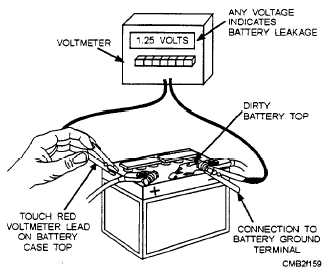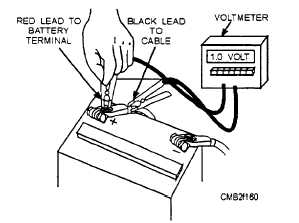A NEEDLE TYPE HYDROMETER uses the same principles as the ball type. When electrolyte is drawn into the hydrometer, it causes the plastic needle to register specific gravity.
A fully charged battery should have a hydrometer reading of at least 1.265 or higher. If below 1.265, the battery needs to be recharged. or it may be defective. A discharged battery could be caused by the following:
Defective battery
Charging system problems
Starting system problems
Poor cable connections
Engine performance problems requiring excessive cranking time
Electrical problems drawing current out of the battery with the ignition OFF
defective battery can be found by using a hydrometerto check each cell. If the specific gravity in any cell varies excessively from other cells (25 to 50 points), the battery is bad. Cells with low readings may be shorted. When all of the cells have equal specific gravity, even if they are low, the battery can usually be recharged.
On maintenance-free batteries a charge indicator eye shows the battery charge. The charge indicator changes color with levels of battery charge. For example, the indicator may be green with the battery fully charged. It may turn black when discharged or yellow when the battery needs to be replaced. If there is no charge indicator eye or when in doubt of its reliability, a voltmeter and ammeter or a load tester can also be used to determine battery condition quickly.
Battery Test
As a mechanic you will be expected to test batteries for proper operation and condition. These tests are as follows:
Battery leakage test
Battery terminal test
Battery voltage test
Cell voltage test
Battery drain test
Battery load test (battery capacity test)
Quick charge test
BATTERY LEAKAGE TEST. - A battery leakage test will determine if current is discharging across the top of the battery. A dirty battery can discharge when not in use. This condition shortens battery life and causes starting problems.
To perform a battery leakage test, set a voltmeter on a low setting. Touch the probes on the battery, as shown in figure 2-6. If any current is registered on the voltmeter, the top of the battery needs to be cleaned.
BATTERY TERMINAL TEST. - The battery terminal test quickly checks for poor electrical connection between the terminals and the battery cables. A voltmeter is used to measure voltage drop across terminals and cables.
To perform a battery terminal test (fig. 2-7), connect the negative voltmeter lead to the battery cable end. Touch the positive lead to the battery terminal. With the ignition or injection system disabled so that the engine will not start, crank the engine while watching the voltmeter reading.

Figure 2-6. - Battery leakage test.

Figure 2-7. - Battery terminal test.
Continue Reading